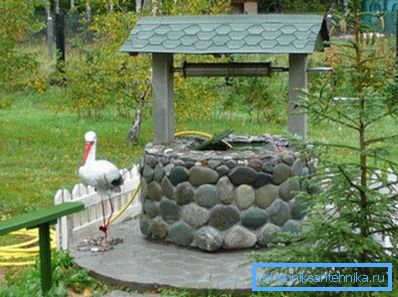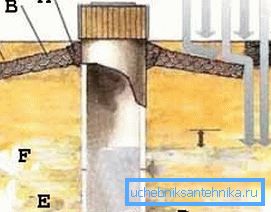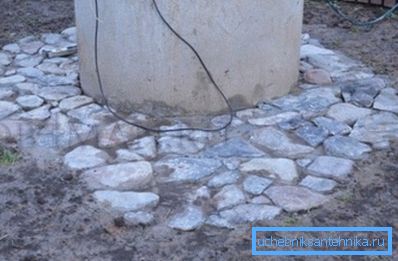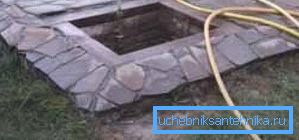How to impose a well of course, independently and according
Lesson in the country for the soul, but do not forget about precautions
If you do not forget that the well is not only an object of hydraulic engineering, but also a “living organism”, which requires very careful attention, then it will not be difficult to lay a well over the well to your liking. If you are going to impose a stone on the well with your own hands or a brick, the algorithm of the works will be approximately the same.

Just do not forget that below you need ground water, on which you will make an additional load on your design. With excessive tension, the ground can “go”, the clay lock of the well will move with it, its protection will be violated. Well, further, the consequences and their price may be irreversible and too high to correct.

Yes, what can I say.
Here is the everyday situation:
- the well regularly gives the cleanest water and everyone is very happy;
- nearby at 10 meters there is a small swimming pool, which is also regularly used;
- the owner wanted to expand the pool;
- work has been done on expanding the meter by 2–3 in all directions, deepening per meter, and
- There is muddy water in the well, which does not pass a day, or two, or a month.
So after all, the work was carried out 10 meters from the well, and we will have to deal directly with its forming rings. Here the risk to break everything is much more.
Small clarification
But first, a small clarification to define concepts. Sometimes the operation “to impose a well” means simply its construction from the very bottom. Often for such a plate serves known to all concrete rings with a height of a meter.
In this article, and this most often, the operation “impose” refers to the design of the upper part of the well, the direct approach to it.
For this work, you need to know how the protective clay castle is made, how deep it is located, and how far it extends from the well.
The position of the lock is shown in Figure A, on which:
- A - part of the whole construction of the castle, which is often made of clay-sand mixture, but is often used for waterproofing the foam plastic plate, covering them on top of the plastic film;
- B - the castle will cover the entire area around the well, going down at an angle of 10 degrees downward at a distance of 2-3 meters;
- C - the composition of this protection - clay, sand, fine gravel, plus a good ramming;
The figure also indicates:
- D - design of the bottom of the well;
- E is the aquifer in which our structure is located;
- F is the lower edge of the waterproof layer;
- G is rainwater, to protect against the penetration of which into the well and build a castle.
Helpful advice! Please note, in the figure indicated by a horizontal arrow, the possible impact on the vertical case of a well of moisture, which somehow got into the well. In this case, the penetration of this moisture through the joints between the rings is dangerous.
But let's not forget that the exact same joint is located at the top, in the place where the facing will be held. We advise you not to forget about this and in no case break this concreted upper joint.
Progress
If you know at what depth is your clay castle and its length from the well, then the work on the lining will not be difficult, do not break only the castle.
Five actions
All work is done in five steps:
- The first - around the perimeter of the future design we extract the soil to a depth of 20 cm, although this value depends on the depth of the castle and the nature of the material used for the decoration, we chose a large natural stone;

- Second - carefully concretes the entire area of soil contact with the external case of the well;

- Third - we pour concrete into the formed niche, a little less than the upper level of the soil, taking into account the subsequent actions;
Helpful advice! Perhaps in this situation, not painfully responsible, this advice can be neglected, but still recall. It is recommended to work with large masses of concrete at one time in order to ensure the same freezing conditions for the entire volume placed. We advise in this case not to depart from this “golden” construction rule.

- Fourth - we submerge the stones in the not yet frozen concrete, already according to our design taste, in accordance with the scheme prepared in advance; as the stones are placed, you will most likely have to remove the surplus of concrete that goes up;

- Fifth - we expect full curing of concrete, and this is 2-3 days for such a layer (according to science, full curing will take place in 2-3 weeks) and check the quality of work.
Helpful advice! When choosing the method of laying stones, be sure to note that they should not be slippery and sharp, especially when wet. Inattention to this inconspicuous, it would seem, nuance may in the future turn into a serious misfortune.
findings
When you complete the construction of your well, protect it with a lock from the penetration of external waters, the desire to impose it on top with stone, brick, pebbles will arise necessarily. It is an excellent exercise to use your free time in the country (also learn how to bring water from the well into the house).
Check only the lock configuration, prepare the materials and go ahead, but preferably after watching the additional video in this article.